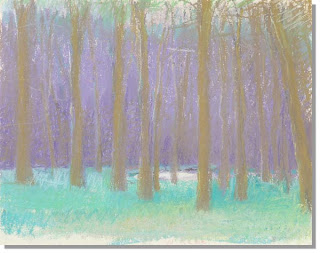
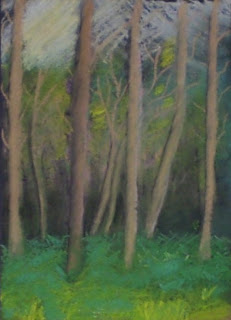
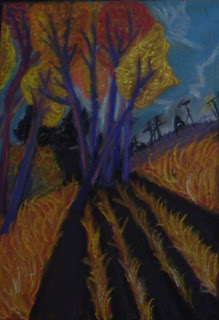
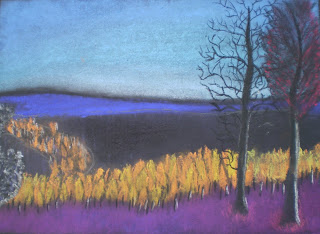
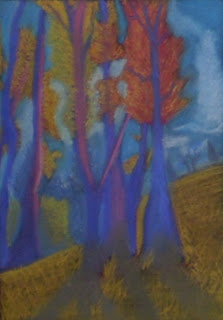
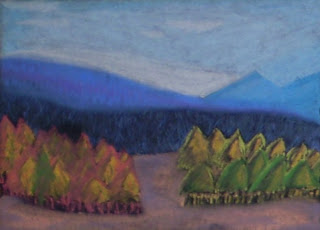

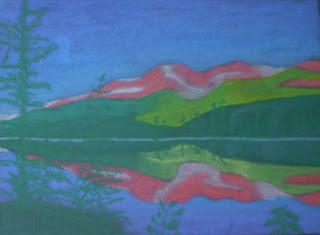 The Art Problem:
The Art Problem:This Creative Challenge invites students to explore mark-making, texture, shape, space, color, abstraction and mood through pastel landscapes inspired by the work of American master, Wolf Kahn. Creating the images on a black ground causes the colors to really "sing" on the paper.
Materials:
Reproductions of Wolf Kahn pastel landscapes
Reproductions of Wolf Kahn pastel landscapes
Selection of the students' own or non-copyrighted landscape photographs (I found a large selection of images in the public domain online through the National Park Service "Digital Image Archive." All images are free and may be used without a copyright release. I printed them out 8.5 x 11", put them in clear page protectors, and use them again and again. This is an excellent opportunity to discuss artistic plagiarism.)
Sketchbook or sketch paper
Pencils
Erasers
Black construction paper, black drawing paper or black pastel paper
Pencils
Erasers
Black construction paper, black drawing paper or black pastel paper
Masking tape (to mask border of paper)
White charcoal pencils if needed for sketches to show up on black paper
White charcoal pencils if needed for sketches to show up on black paper
Selection of colored chalk or soft pastels
Prerequisites:
Basic drawing and composition experience
An understanding of and sketchbook practice with mark-making techniques (hatching, cross-hatching, stippling, etc., including students' own inventive marks)
Basic familiarity with color "mixing" and layering with chalk or soft pastels (or just build in a mini-lesson)
Basic understanding of composition and Elements and Principles of Design
Basic familiarity with color "mixing" and layering using chalk or soft pastels
Individual Student Procedures:
1. Introduce the work of Wolf Kahn. You might do this by giving small groups of students a Wolf Kahn reproduction plus a reproduction of a more realistic landscape and asking them to compare/contrast and then share answers with whole class. The point is to help students recognize basic characteristics of Kahn's pastel landscapes: simplified and often geometric shapes, vivid and sometimes non-local color, color registers or bands of color, a general flattening out of form, etc.
1. Introduce the work of Wolf Kahn. You might do this by giving small groups of students a Wolf Kahn reproduction plus a reproduction of a more realistic landscape and asking them to compare/contrast and then share answers with whole class. The point is to help students recognize basic characteristics of Kahn's pastel landscapes: simplified and often geometric shapes, vivid and sometimes non-local color, color registers or bands of color, a general flattening out of form, etc.
2. Follow the above introductory exercise with a second transitional excercise: place a transparency of Kahn's work on a transparency projector and cover it with a clear transparency sheet. Working with student volunteers and 3-4 images in succession, invite each student to quickly trace the basic shapes of the composition with a transparency marker. After each has completed the tracing, remove the transparency of the artwork so that just the student's diagram of the composition remains. Discuss.
3. Share biographical information about Kahn as desired.
4. Spread out photographs around room and ask students to choose their favorite.
5. Next, students create a thumbnail sketch of their image in pencil and colored pencil. Many students will start out to realistic. Keep reminding them that they are trying to capture the "essence" of the place by doing as Kahn did: reducing forms to simple shapes, exaggerating color and shadow, using mark-making strategies to create contrasting textures, etc. Help them layer varied marks of colors to create secondary and intermediate colors instead of blending. Continually remind them that they are not "copying" the image, but "interpreting" it through abstraction.
6. Students then mask the edges of their black paper with masking tape and translate their thumbnails using white charcoal pencils (or anything that will show up on the paper).
7. Finally, they apply color using chalk or soft pastels. When finished, they fix the image with Workable Fixatif and remove their tape for display.
Assessment:
Score and comment on pieces according to the "Sailing the 7 Cs" visual arts rubric
IB-MYP Area of Interaction: Environment
Extension: Challenge students to create a monoprint of their image. After their pastels are finished, lay a piece of plastic wrap over each image to protect them. Then instruct each student to lay a piece of Plexiglas or acetate over his or her image and trace onto it the basic shapes of his or her composition with a greasy pencil like a china marker. Remove the Plexi/acetate and plastic wrap and put the pastel drawing in a safe place. Next students add color to their compositions with either quickly painted on block printing ink or Caran d'ache water soluble oil pastels (other brands seem not to work). Finally, using pressure from their hands, a brayer, a wooden spoon, or a printmaking press, they transfer their images from the Plexi/acetate onto paper (dry paper for damp block printing ink; barely damp paper for water soluble oil pastels).
Artwork Credits (top to bottom): Wolf Kahn; student artists: Marcus J., Maggie D., *Unknown, *Unknown, Heather J., Sarah G., and Aurelie T.
*I last gave this Creative Challenge in 2007-2008 and cannot recall whose pieces those were; my apologies for not labeling these images.





What a wonderful teacher! A long retired painting professor I began teaching art at the junior and senior high school levels and my heart would break, each time a very interested student became frustrated at not being able to make it look 'real'. My favorite project was also to use a famous landscape artis,t and to promote a 'series' of three 'plates' (of the same dimensions)... #1. a black and white wash and line drawing, #2. a torn magazine collage, and #3. a color media of choice. It seems that after mounting them togther on a larger matt board the finished presentation gave a sense of professionalism..!
ReplyDeleteWHAT A WONDERFUL IDEA... As a new art teacher, I am on the prowl for lesson plans.. I love the idea of doing several small compositions and putting them together. I am wondering if you would be willing to share your lesson plan for this lesson? My e mail is Mcgummie@gmail.com Thank you!!
DeleteI love how this project blends art and emotion—those vibrant Wolf Kahn-inspired colors practically hum off the page! It’s like visual music. Speaking of creativity, I’ve been exploring trending meme soundboard clips lately—check out the latest soundboard unblocked, sound buttons, and meme soundboard unblocked downloads at SoundBoardW.net for instant inspiration!
DeleteWhat a generous comment! Many thanks. I have to admit that I stress drawing from observation in my classroom and incorporating those observed objects and items into innovative, metaphorical compositions with meaning and relevance but I do like this Wolf Kahn challenge for formal reasons.
ReplyDeleteAnd I like your idea of a trio of approaches to the same subject matter mounted together. Thanks for sharing!
Great post,Thanks for providing us this great knowledge,Keep it up.
ReplyDeleteA good blog.
Visit to than play games2girls and play game kids games online ! have fun!
Wonderful, very useful information for me, thank you for sharing
ReplyDelete---
play game click jogos online free | jogos click | jogos no click jogos
Very helpful advice in this particular post!
ReplyDelete----
play game jogos online gratis online and play game unblocked games
Thanks for sharing the information. It is very useful for my future. keep sharing. Can you play more games at: Friv 10000 | Kizi4 | happy wheels games
ReplyDeleteYou need to have time to take care of the kids active. Please visit our website and play exciting flash games.
ReplyDeleteThanks you for sharing!
y5 games
pop games
friv2018 games
Twizl games
zoxy games
pake games
friv game
y1 games
Do you know about skymovieshd
ReplyDeletehdhub4u
Savefromnet .they are great movie downloading site
This lesson brilliantly balances structure and creative freedom, guiding students toward expressive abstraction. It reminds me of the open-ended creativity in Drift Hunters and Drift Hunters Unblocked, where experimentation leads to mastery. Read my review and play Drift Hunters for free at DriftHuntersWorld.com.
ReplyDelete